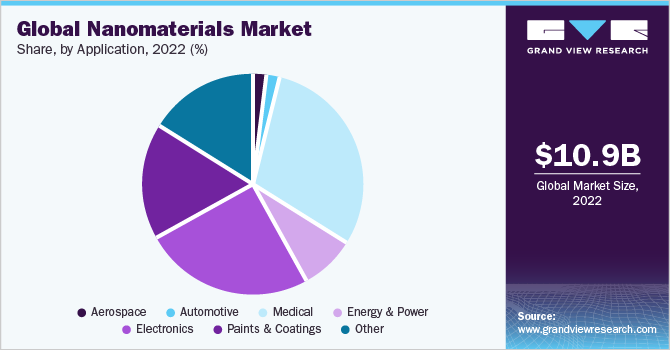Nanomaterials Industry Overview
The global Nanomaterials Market was valued at approximately USD 12.42 billion in 2023 and is anticipated to expand at a compound annual growth rate (CAGR) of 15.0% from 2024 to 2030. This market's growth is expected to be fueled by the increasing demand for nanomaterials in electronic applications, driven by their enhanced surface area during application and high superparamagnetic properties. The use of nanomaterials is also growing in the medical industry due to their application in various in-vitro and in-vivo procedures. The escalating investments by research laboratories and biomedical companies to increase the adoption of nanomaterials in targeted drug delivery, gene therapy, and the treatment of cancerous tumors are projected to further boost market growth.
The production of nanomaterials necessitates a variety of raw materials depending on the manufacturing techniques employed. These raw materials include metals, rare earth metals, alloys, polymers, and composites, which are supplied to both commercial manufacturers and research laboratories. AppliChem GmbH and Bernd Kraft GmbH are key suppliers in the market, providing these essential raw materials.

Detailed Segmentation:
- Material Insights
Titanium nanoparticles accounted for a significant market share in 2023 and are expected to grow at the fastest CAGR of 16.3% over the forecast period. The product is expected to witness increased demand on account of its ability to inhibit bacterial growth and prevent of formulation of further cell structure.
Antimony tin oxide (ATO) nanomaterials are expected to grow at a CAGR of 15.7% over the forecast period. The product is exclusively used as essential components in display panels in the electronics sector owing to their anti-static properties, transparent conductivity, and infrared absorbance.
- Application Insights
The medical application segment accounted for a major share of around 31.2% of the global revenue in 2023 on account of the high penetration of the product for use in the treatment of cancer and other malignant tumors. Furthermore, nanomaterials are used for various specific tasks in medical sector including imaging, targeted drug delivery, nanorobots for surgery, nano diagnostics, cell repair, and nano biosensors.
The aerospace application segment is expected to grow at a CAGR of 12.2% over the forecast period. Rising demand for lighter and more efficient aircraft has driven the rapid adoption of nanomaterials in aircraft manufacturing. Nanomaterials are being used on a large scale in aerospace parts manufacturing including aerostructure, glass, and textile to improve the safety, comfort, and affordability of an aircraft.
- Regional Insights
The Asia Pacific nanomaterials market dominated the market with revenue share of 38.5% in 2023 on account of the growing semiconductor manufacturing industry coupled with rising product penetration. Furthermore, the substantial growth of electronics, medical equipment, aerospace & defense, textiles, and automotive industries in the region is expected to fuel the product demand.
The nanomaterials market in India is growing at fastest CAGR of 19.0% over the forecast period of 2024 to 2030. Nanomaterial is one possible means of bridging the gap between India’s abundant, varied natural resources and ever-increasing needs such as medical, electronics, hygienic water and food, and high-quality textiles.
China nanomaterials market is anticipated to witness the fastest growth due to increasing investments in research and development activities for biomedical, electronics, energy, and wastewater treatment applications.
Gather more insights about the market drivers, restraints, and growth of the Nanomaterials Market
Key Companies & Market Share Insights
Some of the key players operating in the market include Strem, American Elements, and Nanophase Technologies Corporation.
- Strem is engaged in the production and distribution of high-purity specialty chemicals. It manufactures nanoparticles using a wide range of materials such as aluminum, nickel, iron, carbon, cadmium, calcium, gold, silicon, tin, zinc, and silver. It provides products to the government, manufacturing industries, and academic development & research laboratories.
- Nanophase Technologies Corporation manufactures and supplies a wide range of engineered and advanced materials. It offers several customer-proprietary formulations through its global network of manufacturing facilities. The products manufactured by the company are used in a wide range of applications including energy, aerospace, automotive, defense, and pharmaceutical or medical.
Key Nanomaterials Companies:
The following are the leading companies in the nanomaterials market. These companies collectively hold the largest market share and dictate industry trends.
- Strem
- American Elements
- US Research Nanomaterials, Inc.
- nanoComposix
- Frontier Carbon Solutions, LLC.
- Nanoshel LLC
- SkySpring Nanomaterials, Inc.
- Nanophase Technologies Corporation
- Cytodiagnostics Inc
- Quantum Materials Corporation
Order a free sample PDF of the Market Intelligence Study, published by Grand View Research.
Recent Developments
- In December 2023, California NanoSystems Institute at University of California, Los Angeles (UCLA) launched the nanoparticles made with six medium-entropy alloy nanoparticles combined nickel, palladium, and platinum. The material is used for medium- and high-entropy alloys essential components of buildings, transportation, appliances, tools, and electronic devices.
- In April 2021, NanoComposix improved the development of its process for scaling up the 40 nm gold citrate particles for use in lateral flow diagnostic assays. This capability can increase production to at least 100 L at 20 OD, allowing for the production of 30-50 million lateral flow strips per month.


No comments:
Post a Comment